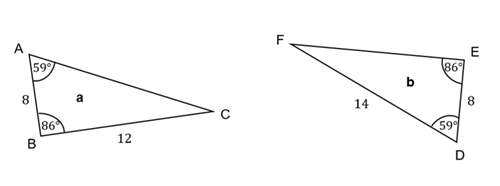The NWEA MAP Growth Test for 9th Grade tracks early high-school progress by assessing critical thinking, analytical reasoning, and problem-solving skills. I’m Ariav Schlesinger, a MAP Growth specialist presenting a clear overview of what the 9th grade assessment measures and how to prepare for it.
This page includes:
- Free 9th grade MAP questions in Math, Reading, and Language Usage
- Explanations that enhance reasoning and accuracy
- A summary of skills evaluated during the first year of high school
- Score information and tips for interpreting results
Explore free questions and see how our preparation resources build confidence and academic growth throughout high school.
Free 9th Grade MAP Growth Sample Questions
Math Sample Questions
In 9th grade, students build on middle school math with a stronger focus on Algebra I and Geometry. Key MAP Math areas include:
- Solving and graphing linear equations and inequalities
- Working with exponents and expressions
- Understanding and applying functions
- Exploring geometry concepts such as congruence, similarity, perimeter, and area
These skills lay the groundwork for Algebra II and advanced high school math.
Reading Sample Questions
In 9th grade students strengthen their ability to analyze both literature and informational texts. They learn to:
- Identify themes and central ideas
- Analyze character development and relationships
- Evaluate arguments and supporting evidence in nonfiction
- Interpret tone, perspective, and author’s purpose
MAP Reading assesses these skills using complex reading passages that reflect the higher expectations of high school.
Language Usage Sample Questions
In 9th grade, students develop more advanced grammar and writing skills to express their ideas clearly. The MAP Language Usage tests:
- Using correct punctuation and mechanics
- Refining word choice for precision and tone
- Combining and restructuring sentences for clarity and flow
- Strengthening essays and research papers with proper grammar and style
These skills not only support classroom writing but also prepare students for standardized tests and future academic challenges.
Understanding Your 9th Grader's MAP Scores
It's natural to wonder what a "good" score is, but for 9th graders, the initial RIT score is best viewed as a starting line, not a final grade. The most important metric is consistent with percentile growth from that starting point. Ninth grade MAP scores show how well students are adapting to higher expectations: building stronger study habits, tackling more complex reading, and thinking critically across subjects. This growth reflects the transition to high school and sets the tone for continued learning in the years ahead.
A student's growth trajectory is a much better predictor of future success than any single score. The goal is to see an upward trend over time. For example, steady percentile improvement is often a stronger indicator than a high initial score. A significant drop or a flat line in scores is not a reason to panic, but it is a signal to connect with your child's teacher. Identifying a challenge early is the first step to addressing it effectively.
For a more detailed review of MAP Growth scores, visit our MAP Test Scores page.
Freshman MAP Growth PrepPack: Build a Strong Academic Foundation
Starting high school is a meaningful step and so is preparing for the MAP Growth test. Our team of educators and test-prep experts designed this PrepPack to help strengthen students’ critical thinking reasoning, and ability to apply knowledge across subjects. In 9th grade, effective preparation builds confidence, teaches endurance for longer assessments, and introduces strategies that make complex material approachable. With steady, guided practice, freshmen develop the habits that lead to lasting academic growth.
- Full-Length Practice Tests: Replicate the 9th-grade MAP Growth experience to build focus and stamina. Students can retake tests anytime to improve pacing and accuracy.
- Progressive Practice Questions: Move gradually from essential skills to higher-level reasoning in reading, math, and language, helping students think more deeply about each question.
- Step-by-Step Explanations: Detailed solutions walk students through every answer, reinforcing understanding and effective problem-solving approaches.
- Targeted Skill Drills: Strengthen vocabulary, grammar, reading analysis, algebra, and geometry—the core areas that shape high-school success.
- Strategy Tips: Teach students how to manage time, stay motivated, and approach challenging questions with confidence.
- Progress Tracking: Highlights growth across practice sessions, helping students and parents celebrate progress and identify next steps.
Supporting Your 9th Grader’s MAP Growth Journey
The transition to high school requires new organizational skills and more independence, both of which directly impact MAP Growth scores. Your role is to help your teen build effective systems they can manage themselves to ensure consistent academic progress, which the MAP test measures.
Here are a few practical strategies focused on fostering the skills needed for success on the assessment and beyond:
- Create a central study system: The heavy workload in high school can be overwhelming, causing important study tasks to be missed. Help your teen set up a single system. Use a planner, whiteboard, or digital app where they can track all assignments and test dates. This builds essential organizational habits that ensure they regularly study all the complex topics measured by the MAP RIT scores.
- Use time-blocking for balance: The MAP Growth test measures skills across several subjects, so steady, balanced practice matters more than cramming. Encourage your teen to dedicate set times to specific subjects. For example: Monday 7:00–7:45 PM for Algebra, 7:45–8:30 PM for Language Arts. This structure builds focus and retention over time.
- Reflect on mistakes: Encourage your teen to see homework and quizzes as tools for learning, not just grades. The goal is to understand the root cause of an error, which strengthens the critical thinking and problem-solving skills the MAP test evaluates. This shifts the focus from chasing perfection to building the real content knowledge and resilience that drives academic improvement.
Ask Ariav

Ariav Schlesinger is a certified teacher with a Master's in Education and a MAP Growth specialist with over a decade of experience developing 9th Grade MAP-aligned questions. His materials include clear explanations that strengthen critical thinking across math, reading, and language usage, build advanced reasoning and problem-solving skills, and help 9th graders gain confidence and perform their best on the MAP Growth test.
FAQs for 9th Grade Parents
Typically, students take MAP three times during the school year in fall, winter, and spring. This allows teachers and parents to track growth over time, not just a single snapshot.
No. MAP results do not affect course grades. Instead, they help educators understand your teen’s strengths, identify areas for improvement, and make better-informed placement and support decisions.
There is no single “good” score. What matters most is steady growth compared to your child’s own past performance.
The skills measured by MAP Growth are algebra, data analysis, reading comprehension, and writing. They closely align with college entrance exams. Strong MAP scores are an early sign that your child is on track for success on the SAT, ACT, and state assessments.
Often, yes. While schools look at grades, teacher recommendations, and student motivation, MAP scores provide an objective measure of readiness for advanced coursework. A strong MAP performance may open the door to honors, AP, or dual-enrollment opportunities.
Each subject test generally takes 45–60 minutes, but the exam is untimed. Students can work at a comfortable pace, reducing pressure and test anxiety.
Help your teen establish healthy routines such as regular study habits, enough sleep, and balanced schedules. Encourage consistent effort and growth, not perfection. Reviewing MAP results together can also help set meaningful goals for the school year.



